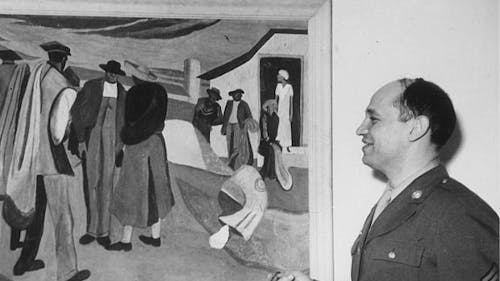Art history professor highlights iconic Black artists

Happy Black History Month! In an engaging conversation with Professor Amber Wiley, a professor in the Department of Art History, we’re looking at how Black people have impacted and continue to impact the ever-evolving art world.
The work of the many artists that Wiley covers in her African-American Art class helps visually express the Black experience in America through a creative lens.
Many of us know of the Harlem Renaissance of arts and culture in the Roaring '20s. This movement saw the brilliant work of artists like Aaron Douglas, Jacob Lawrence, Augusta Savage, Palmer Hayden, James Van Der Zee and Archibald Motley emerge into the spotlight.
Today, the contemporary work of trailblazers like Kerry James Marshall, Mickalene Thomas, Kara Walker and Kehinde Wiley, who famously painted former President Barack Obama’s verdant presidential portrait in 2018 might come into mind.
One of my favorite Black artists is Sam Gilliam, a Washington color school painter, whose abstract expressionist canvas work is currently on display at the Zimmerli Art Museum on the College Avenue campus. Currently on view in the American Art Gallery is revered early 20th century painter Henry Ossawa Tanner’s “The Good Shepherd,” which is also a beautiful and exciting gem in the museum’s collection.
When I asked Wiley about groundbreaking artists who have helped define Black art in modern and contemporary history, she said, “One person comes to mind immediately: Romare Bearden. He shifted from social realism and looking at the lives of everyday people, to abstraction in the '50s, to finally coming into his own in the ('60s) by taking different aesthetic notions and materials in creating something new. He was influenced by African masks that he saw in the '20s, 30's and the Harlem Renaissance. He uses photographs and magazines and makes collages and includes paint. He is very inventive and creates really striking images.”
Wiley said that the Zimmerli Art Museum has a good collection of Black art. “We do have Bearden('s painting). It's in the American Art Gallery and it's one of his earlier pieces from 1945. The shapes and the colors, they're really active and engaging. If you look at the shapes within that piece, you can see how he continues on that kind of aesthetic and his later work. That piece is ‘The Adoration of the Magi,’” she said.
There are powerful Black women that inform Black art too. “Faith Ringgold again starts with painting, but then moves into more creative types of materials. Quilting, for instance, is like an old tradition but she creates it in a new way. She has really good storytelling capacities, as does Bearden, in her ability to manipulate various types of mediums and tell some really moving stories. She inspired other Black women artists who would come after her,” Wiley said.
Honoring the work of Black artists is a key aspect of commemorating Black History Month and the cultural expanse of Black art is larger than we think it is.
“Most people think African American art started with the Harlem Renaissance. What I try to show my students is that African Americans have contributed to the aesthetic traditions of America since coming here in the 1600s. We look at Monticello, Thomas Jefferson's grand plantation, his beautiful house. We learn about the carpenters who worked there and were trained, in what were literally called 'apprenticeships,'" she said. "I have students who say, 'I’ll never look at Monticello the same.' And I’m like, 'Good!' Black Americans, enslaved and free, have long participated in the tradition of making and I think that’s important for people to see."
“It’s also important to see how people were able to express their individuality and run with their imagination, even in some of the most dire circumstances. Black music is this thing where they make music out of oppression, with blues, jazz and rap. But people made visual art too. I see those kind of threads similarly. It's kind of a resistance, and quite frankly, the desire to do what you want to do in times where people probably think: 'What in the world are you doing? You want to be an artist? We still don’t have the right to vote,'" she said. "They need someone to tell those stories so that's why I think art is important as a part of Black History Month celebration. Go to the Zimmerli (Art Museum) and seek out some of these pieces."



